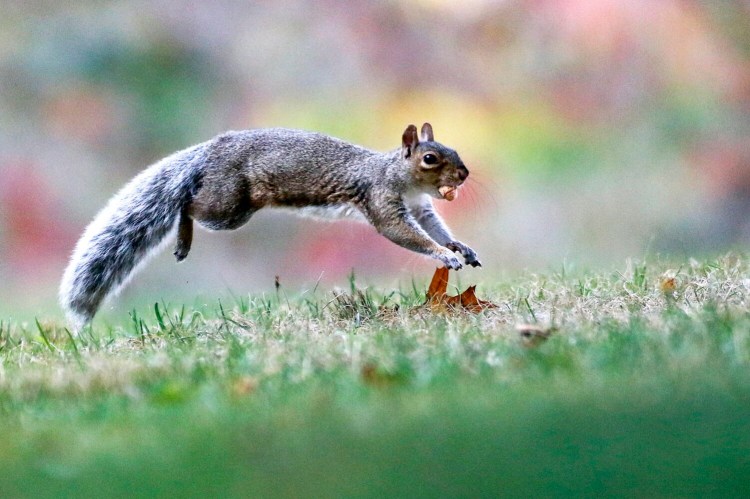A cornucopia of acorns has been falling from oak trees this season, a phenomenon that happens roughly every two to five years for reasons that defy scientific explanation.
The irregularity of “mast years” is endemic across the entire oak kingdom and is believed to be an evolutionary adaptation. It helps keep populations of rodents and other animals that feed on acorns down during lean years, while producing enough acorns during mast years to allow for oak propagation.

Acorns are in abundance this year. Carl D. Walsh/Staff Photographer
Scientists believe weather conditions and populations that feed on acorns may factor into the cycle of mast years, but those factors don’t adequately explain why all oak trees of a particular type tend to produce an excess of mature acorns at seemingly random intervals on a synchronized schedule. It’s a mystery that has baffled botanists for centuries.
In Portland, mast years tend to lead to more calls for city services as some residents, overwhelmed by the blanket of slippery, critter-attracting acorns in their yards, seek help removing them, according to city arborist Jeff Tarling.
“We’ll get calls from residents saying, ‘There’s a lot of acorns in my yard … and I hate raking them up,’ ” Tarling said. “It becomes more of an issue to homeowners who have to rake leaves and then have to rake acorns for weeks at a time.”
But Tarling said mast years serve an important function in nature. Not only do they help replenish the oak population, they also provide food for animals such as mice, squirrels, jays, pigeons and even ducks. That, in turn, makes food more plentiful for predators such as raptors, he said.
Tarling recalled that in November 2018, a great black hawk took up residence in Portland’s Deering Oaks in what has been described as the most unusual bird sighting in Maine in decades. The hawk, native to Central and South America, first appeared in August 2018 in Biddeford before making its way to Portland.
The hawk’s presence was likely attributable to an explosion in New England’s Eastern gray squirrel population in 2018 following a mast year for acorns the year before, Tarling said. The plentiful acorns ensured the squirrels were well-fed and produced more offspring, which in turn provided the great black hawk and other predators with food.
“There’s no question that, particularly in the woodland areas, it’s definitely a boon to wildlife – everything from birds to mammals that eat the seed,” he said.
Acorns are high in nutritional content but can’t be consumed safely by all animals, particularly some larger ones. They contain valuable protein, fats, carbohydrates and B vitamins, but also acidic tannins that not all animals have the ability to safely metabolize.
Bears, deer and pigs are able to break down the tannins without issue, but acorns can cause a slow and painful death in horses and cows if eaten in high enough quantities.
The bitter tannins are largely responsible for the acorn falling out of favor as a food source for people, although it was once a staple in some European, Native American and other cultures. According to a 2014 article in Scientific American, the Roman natural philosopher Pliny the Elder referred to the oak as the “tree which first produced food for mortal man.”
Plentiful in mast years and easy to store, acorns were valued for their high energy content, and a variety of methods were developed to leach out the undesirable tannins so the acorns could be ground into flour.
The rise of more easily processed grains led humans to largely abandon the acorn as a food source. But farmer and baker David Koubek, co-owner of The Good Shepherd’s Farm in Bremen, noted that there are still adventurous bakers out there willing to work with acorn flour.
“I’ve never tried it, but I’ve been wanting to try it,” he said.
Koubek, who was selling a variety of breads and other products at the Portland Farmers’ Market on Saturday in Deering Oaks, said acorns from the white oak appear to be more palatable to humans than those from the red oak because they have a lower tannin content. Properly processed acorn flour from white oaks can be used to make crackers, pancakes and other foods, he said.
Another vendor at the farmers market who expressed an interest in the history of acorns as a food source was Genna Ulrich of Serendipity Acres in North Yarmouth, which raises organic, pasture-fed poultry.
Ulrich has read up on the subject and believes the leaching process, which tends to involve soaking chopped acorns in successive fresh pots of boiling water, could be feasible for someone who uses a wood stove for heating and has the stove burning all day anyway during the winter.
Ulrich marveled at the strange nature of the acorn’s boom-and-bust cycle, especially the fact that all oak trees of a given variety seem to automatically follow what the others are doing.
“Why would the trees coordinate?” they said. “Why do they do it?”
Comments are not available on this story.
Send questions/comments to the editors.



